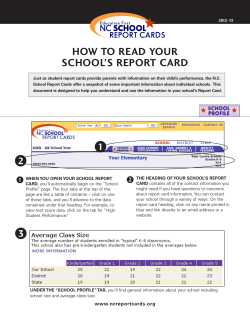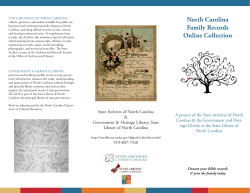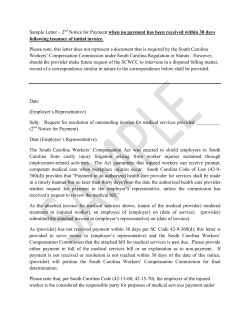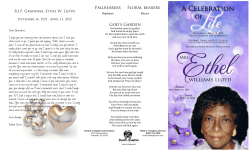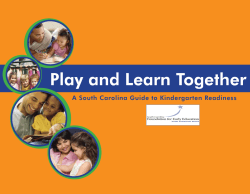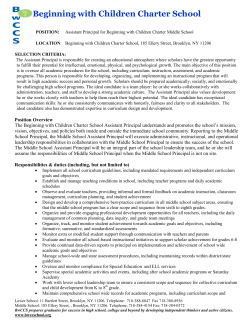
HOW TO READ YOUR K–8 CHARTER SCHOOL REPORT CARD 2012-13
2012-13 A GUIDE TO READING YOUR CHARTER SCHOOLʼS REPORT CARD HOW TO READ YOUR K–8 CHARTER SCHOOL REPORT CARD Just as student report cards provide parents with information on their child’s performance, the NC School Report Cards offer a snapshot of some important information about individual schools. This document is designed to help you understand and use the information in your school’s report card. SCHOOL PROFILE Under “School Profile,” you’ll find general information about your school including school size and average class size. School Size is important because it can influence the types of academic programs or activities (such as sports and music) that a school can offer. Class Size may influence the one-on-one attention that teachers provide to students and the level of classroom discipline. How does your child’s class size compare with the school’s average and class size averages in the state? Ask your school principal about targeted class sizes in your school. Source of Funds (Amount per Student) shows you where your school’s funding comes from and how much money it receives per student from state, federal, and local sources. Education funds are generated mostly through federal and state income taxes as well as county property and sales taxes. When comparing the distribution of funds in your school with the state average, note that state and federal funding are adjusted by the financial needs of communities so the sources of funds may differ substantially from the state averages shown. For an estimate of total spending per student in your school, add the dollar amounts for the three charter school funding bars together. Use of Funds provides an overview of charter school operating budgets. Use this graph to learn more about how your school spends money day-to-day for operations. Title I Status indicates whether this school is part of the federal program that provides funding for high poverty schools to help students who are behind academically or at risk of falling behind. HIGH STUDENT PERFORMANCE There are a number of ways to measure student performance; state test results are just one of the measures that are covered in your school’s Report Card. On a school-by-school basis, there are additional ways to evaluate student performance as well. Look at student grades, at the percentage of students earning top grades or repeatedly failing, and ask for information about student projects and academic clubs and activities. These additional measures are important and can help you form a more complete picture of student academic achievement in your school. Performance of Students in Each Grade on North Carolina End-of-Grade Tests helps you to see what percentage of students passed the End-of-Grade reading test and the End-of-Grade math test in the spring of 2013. Look for large differences in performance across grade levels. Talk to your child’s teacher to learn more about how your school is working to increase academic achievement. Performance of Each Student Group on the North Carolina End-of-Grade tests displays test results so that differences in passing rates (often referred to as achievement gaps) between students of different ethnicities, gender, family circumstances, or racial backgrounds are apparent. North Carolina is working hard to eliminate performance differences between the groups of students listed here and your school’s overall performance depends partly on closing these “gaps.” Find out what your school is doing to close achievement gaps and what you might be able to do to help. Annual Measurable Objectives (AMOs) — In 2011-12, the U.S. Department of Education granted North Carolina waiver request from some of the requirements of the Elementary and Secondary Education Act. As stated in the waiver, beginning in 2011-12, Adequate Yearly Progress (AYP) was not reported for schools; however, the overall number of Annual Measurable Objectives (AMOs) for each school and the number and percent of AMOs met for each school were reported. For both reading and mathematics, AMOs were set and reported for the school as whole and for the following subgroups when they contain 40 or more students: white, black, Hispanic, American Indian, Asian, Pacific Islander, Two or More Races, economically disadvantaged, limited English proficient, and students with disabilities. PAGE 2 A GUIDE TO READING YOUR CHARTER SCHOOLʼS REPORT CARD SAFE, ORDERLY & CARING SCHOOLS Under “Safe, Orderly & Caring Schools,” you can find measures for school safety and access to technology. School Safety is critical to learning. To find out more about what and where incidents of crime or violence have occurred in your school, speak with your school principal. For information about school disciplinary actions like out-of-school suspensions and expulsions, view your School Report card online at www.ncreportcards.org. Access to Technology in your school building can help you understand more about the instructional resources available in your school. In addition to knowing what percent of classrooms in your school are connected to the Internet, you might also ask school administrators about the speed of Internet connections, the number of Internet-connected computers (and digital devices) in classrooms with connections, and how teachers make use of the Internet for instruction. QUALITY TEACHERS Most people—parents and education experts alike—agree that good teachers are critical to students’ success in learning at school. By looking at some measures of teacher qualifications, you can better understand the overall quality of the teachers working in your school. Fully Licensed Teachers — One measure of teacher quality is whether or not a teacher has been granted a teaching license. The types of teaching licenses vary as teachers progress from beginning to more experienced. When a teacher is called “fully licensed,“ he/she has met all of the requirements and teaching standards set by North Carolina’s State Board of Education. Highly Qualified Teachers — One of the important provisions of No Child Left Behind (NCLB) is a requirement that all teachers of core academic subjects must be Highly Qualified. North Carolina already has rigorous standards for teacher licensure and this federal law adds one more way in which teacher qualifications can be measured. This table provides information about the percentage of classes taught by teachers who currently meet the federal Highly Qualified definition in this school and in the state. Highly Qualified teachers are generally defined as teachers who are fully licensed (also called certified) by the state. They hold at least a bachelor's degree from a four-year institution, and they demonstrate competence in the subject area(s) they teach. The standards for Highly Qualified only apply to teachers in core subject areas: English, reading, language arts, mathematics, science, foreign languages, civics and government, social studies, economics, arts, history, geography, and kindergarten through grade 6. The federal regulations do not apply to non-core subject area teachers such as vocational teachers or physical education teachers. Because the criteria and the timeline for highly qualified teachers can vary so much from teacher to teacher, it is very important that conclusions about these data only be drawn after additional research and detailed discussion with your school principal. Many effective, quality teachers may not currently meet the federal definition of Highly Qualified, but the state expects its numbers of Highly Qualified teachers to increase as rules become more clear and requirements are fully communicated to teachers. KEEP IN MIND... Use district and state averages as reference points in reading school-level data. Remember that these averages only provide an indication of how favorable the data might be. In many instances, it would be a mistake to judge a school as “better” or “worse” based only on slight differences in this data. Additional data about your school are available through your school’s web-based School Report Card at www.ncreportcards.org. Use your online School Report Card to learn more about schools and to link to additional tips for understanding and using School Report Card information.
© Copyright 2025





